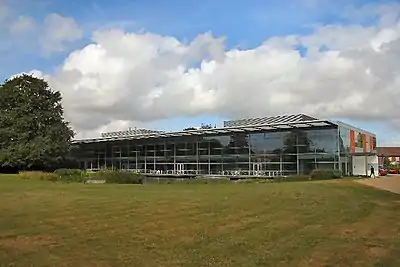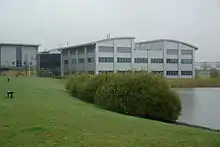Silicon Fen
Silicon Fen (sometimes known as the Cambridge Cluster) is the name given to the region around Cambridge, England, which is home to a large cluster of high-tech businesses focusing on software, electronics and biotechnology, such as Arm and AstraZeneca. Many of these businesses have connections with the University of Cambridge, and the area is now one of the most important technology centres in Europe.

It is called "Silicon Fen" by analogy with Silicon Valley in California, because it lies at the southern tip of the English Fenland. The interest in technology in the area started with Sinclair Research and Acorn Computers.[1]
Business growth
More than 1000 high-technology companies established offices in the area during the five years preceding 1998.[2] Some early successful businesses were Advanced RISC Machines and Cambridge Display Technology.[1] In 2004, 24% of all UK venture capital (8% of all the EU's) was received by Silicon Fen companies, according to the Cambridge Cluster Report 2004 produced by Library House and Grant Thornton.
The so-called Cambridge phenomenon, giving rise to start-up companies in a town previously only having a little light industry in the electrical sector, is usually dated to the founding of the Cambridge Science Park in 1970: this was an initiative of Trinity College, Cambridge University and moved away from a traditional low-development policy for Cambridge.
The characteristic of Cambridge is small companies (as few as three people, in some cases) in sectors such as computer-aided design. Over time the number of companies has grown; it has not proved easy to count them, but recent estimates have placed the number anywhere between 1,000 and 3,500 companies. They are spread over an area defined perhaps by the CB postcode or 01223 telephone area code, or more generously in an area bounded by Ely, Newmarket, Saffron Walden, Royston and Huntingdon.
In 2000, then Chancellor of the Exchequer Gordon Brown set up a research partnership between MIT and Cambridge University, the Cambridge–MIT Institute, in order to increase international collaboration between the two universities and to strengthen the economic success of Silicon Fen.
In February 2006, the Judge Business School, Cambridge University reported estimates that suggested that at that time, there were around 250 active start-ups directly linked to the University, valued at around US$6 billion. Several of these companies have grown into multinationals: ARM, Autonomy Corporation and AVEVA are the most obvious examples, and more recently CSR has seen rapid growth due to the uptake of Bluetooth.
It was found in 2012 that strong employment growth was hampered due to the concentration on research and development. This was because of limited competition in manufacturing capability and its consequent cost.[3]
Recent work by Cambridge Ahead, the business and academic membership organisation dedicated to the successful growth of the city region in the long-term, has shown that in 2015-16, growth of Cambridge companies continued at around 7% on a one, three and five-year view. Global turnover of Cambridge companies increased by 7.6% to £35.7bn, up from £33bn the previous year, and global employment grew by 7.6% to 210,292. The number of companies with their home base within 20 miles of Cambridge has grown from 22,017 to 24,580.[4]
What is striking about the data is that 2015-16 was just another typical 7% growth year for Cambridge. Over the past five years (2010-11 to 2015-16) the turnover of Cambridge companies has grown by 7.5% per annum, and employment by 6.6% per annum.
The growth of Silicon Fen was best revealed by the Cambridge Cluster Map, a data tool that accurately mapped the growth of the Cambridge sub-region over time and revealed the true extent of the success of the ‘Cambridge Phenomenon’. The map was created and launched in July 2016 by Cambridge Ahead in partnership with Barclays, working with the Centre for Business Research (CBR) at the University of Cambridge, and was an updated version of the previous Cluster Map covering the Tech sector launched in 2012.
The new dataset identifies and locates companies and certain research facilities that are active within a 20-mile radius of the centre of the city and shows three types of organisations: Cambridge-based companies, Cambridge-active companies, and Non-corporate Knowledge-intensive (KI) organisations.
Area characteristics
The region has one of the most flexible job markets in the technology sector, and people are often employed by other companies after a start-up fails. Although everyone wants their company to succeed, failures are tolerated, indeed almost expected.
One reason for the area's success is that after some time such an employment market is self-sustaining, since employees are willing to move to an area that promises a future beyond any one company. Another factor is the high degree of 'networking', enabling people across the region to find partners, jobs, funding, and know-how. Organisations have sprung up to facilitate this process, for example the Cambridge Network.
Another factor is the academic pre-eminence of Cambridge University, which is one of the top 5 universities in the world, a high standard of living available in the county, and good transport links, for example to London and with Cambridge Airport having a full service business jet centre. Many graduates from the university choose to stay on in the area, giving local companies a rich pool of talent to draw upon. [5] The high-technology industry has little by way of competition, unlike say in Oxfordshire where many other competing industries exist. Cambridgeshire has not until recently been a high-technology centre, which meant commercial rents were generally lower than in other parts of the UK and thus giving companies a head-start on those situated in other more expensive regions. However, the recent technology boom has changed the situation and Cambridgeshire now ranks as one of the highest costs of living in the UK outside London.[6]
Companies and individuals associated with Silicon Fen
- Abcam
- Acorn Computers
- Adder Technology
- Andy Hopper
- ARM Holdings
- AVEVA
- Broadcom
- Cambridge Broadband
- Cambridge Consultants
- Cambridge Interactive Systems Ltd
- Cambridge Network
- CamSemi
- Camcon Technology
- Cantab Capital Partners
- CSR plc
- DANTE
- Darktrace
- David Cleevely
- Dick Newell
- DisplayLink
- Docker, Inc.
- Endomag
- Ewan Kirk
- Global Silicon Limited
- Hermann Hauser
- ip.access
- Jagex
- Sartorius Stedim TAP, formerly part of Sartorius AG
- Sinclair Research
- Sagentia, formerly Scientific Generics
- Sherry Coutu
- ST Robotics
- Team Consulting
See also
References
- The Cambridge Cluster Report 2007, Library House 2007, Download
- The Cambridge Phenomenon: The Growth of High Technology Industry in a University Town, Segal Quince & Partners 1985, ISBN 0-9510202-0-X
- Worthington, Tom (1999). "The Cambridge Phenomenon: Summary of The Report". Net traveller: exploring the networked nation. Australian Computer Society. ISBN 0-909925-74-7.
- The Cambridge Phenomenon Revisited - a synopsis of the new report by Segal Quince Wicksteed, Segal Quince & Partners 2000, Download
- The Cambridge Cluster Report 2003, Library House 2003, Download
- The Cambridge Cluster Report 2004, Library House in association with Grant Thornton 2004, Download
- The Cambridge Cluster Report 2006, Library House 2006, Download
- The Cambridge Technopole Report 2006 An overview of the UK's leading high tech cluster, St John's Innovation Centre 2006,
- The Impact of the University of Cambridge on the UK Economy and Society A high-level study commissioned by EEDA and the Cambridge Network in 2006,
- INSIGHTS & RESEARCH | WHAT IS SILICON FEN? bidwells.co.uk,
- Jones, Kevin (1 December 1998). "US Report: Old Cambridge targets high-tech success". ZDNet. Retrieved 15 December 2011.
The focus on technology in the so-called Silicon Fen started two decades ago with Acorn Computer PLC, which became the U.K.'s leading personal computer maker until the advent of Windows. The Fen also spawned a couple of successes, such as Advanced RISC Machines Ltd., a virtual chip designer; Cambridge Display Technologies Ltd., a monitor maker [...]
- Ibrahim, Youseff M. (4 January 1998). "In Old England a Silicon Fen: Cambridge as a High-Tech Outpost". The New York Times. Retrieved 13 June 2012.
- Andersen, Christian; Bailey, Jonathan; Heal, Adam; Munn, Oliver; O'Connell, Bryan (4 May 2012). "IT Hardware cluster: Cambridge, United Kingdom" (PDF). Final Paper; Microeconomics of Competitiveness, Harvard Business School. Harvard Business School. Archived from the original (PDF) on 19 June 2012. Retrieved 18 June 2012.
- "Latest data from Cambridge Ahead reveals unabated growth of Cambridge companies". www.cambridgeahead.co.uk. Cambridge Ahead. 24 January 2017. Retrieved 14 May 2017.
- "5 Reasons Cambridge is Great for Students". Top Universities. 3 November 2016. Retrieved 19 November 2019.
- "Cambridge". Cost Off Living. Retrieved 19 November 2019.




